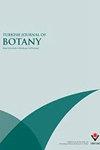大麦XTH基因家族的计算机分析及其在发芽过程中的比较表达分析
IF 1.5
4区 生物学
Q3 PLANT SCIENCES
引用次数: 2
摘要
:植物细胞壁的变化对扩张和生长至关重要。木葡聚糖内转糖基酶/水解酶(XTH)是细胞壁内木葡聚糖的主要修饰物,并作为大基因家族存在。尽管大麦中缺乏木葡聚糖,但我们对大麦基因组的分析显示,至少有42个XTH基因,是迄今为止单子叶植物基因组中记录的XTH成员最多的基因。在本文中,我们对大麦XTH基因家族进行了详细的研究,包括保守蛋白基序和结构的详细生物信息学分析、系统发育关系,以及使用RT-qPCR和RNA-Seq分析比较发芽和幼苗生长过程中的表达模式。总体而言,类似组织的RT-qPCR和RNA-Seq数据之间存在良好的相关性。RNA-Seq数据显示了许多不同的表达谱模式,从一些XTH基因的广泛、高水平表达到其他基因的高度组织特异性模式。RT-qPCR表达模式在基因之间也有很大差异。表达最高的基因HvXET4的水平大约是最高对照基因微管蛋白的五倍。鉴于大麦中发现的木葡聚糖含量较低,这种高水平的表达表明该酶可能在催化与其他细胞壁多糖的反应。基于本文所示的结果,我们提出了许多HvXTH基因的作用。本文章由计算机程序翻译,如有差异,请以英文原文为准。
In silico analysis of XTH gene family from barley (Hordeum vulgare L.) and theircomparative expression analysis during germination
: Changes in plant cell walls are critical for expansion and growth. Xyloglucan endotransglycosylase/hydrolase (XTH) enzymes are the major modifiers of xyloglucan within the cell wall and are present as large gene families. Despite the paucity of xyloglucan in barley, our analyses of the barley genome revealed at least 42 XTH genes, the most XTH members recorded for a monocot genome to date. In this paper, we show a detailed look at the barley XTH gene family, including detailed bioinformatics analyses of conserved protein motifs and structure, phylogenetic relationships, and a comparison of the expression patterns during germination and seedling growth using RT-qPCR and RNA-Seq analyses. Overall, there was a good correlation between RT-qPCR and RNA-Seq data for similar tissues. RNA-Seq data showed many different expression profile patterns, from broad, high level expression for some XTH genes to highly tissue specific patterns for others. RT-qPCR expression patterns also varied widely between genes. The highest expressing gene, HvXET4 , had levels around five times that of the highest control gene tubulin. Given the low levels of xyloglucan found in barley, this high level of expression suggests that the enzyme may be catalysing reactions with other cell wall polysaccharides. We propose roles for many of the HvXTH genes based on the results shown here.
求助全文
通过发布文献求助,成功后即可免费获取论文全文。
去求助
来源期刊

Turkish Journal of Botany
PLANT SCIENCES-
CiteScore
2.90
自引率
5.60%
发文量
31
审稿时长
6-12 weeks
期刊介绍:
The Turkish Journal of Botany is published electronically 6 times a year by the Scientific and Technological Research Council of Turkey (TÜBİTAK) and accepts manuscripts (in English) covering all areas of plant biology (including genetics, evolution, systematics, structure, function, development, diversity, conservation biology, biogeography, paleobotany, ontogeny, functional morphology, ecology, reproductive biology, and pollination biology), all levels of organisation (molecular to ecosystem), and all plant groups and allied organisms (algae, fungi, and lichens). Authors are required to frame their research questions and discuss their results in terms of major questions in plant biology. In general, papers that are too narrowly focused, purely descriptive, or broad surveys, or that contain only preliminary data or natural history, will not be considered (*).
The following types of article will be considered:
1. Research articles: Original research in various fields of botany will be evaluated as research articles.
2. Research notes: These include articles such as preliminary notes on a study or manuscripts on the morphological, anatomical, cytological, physiological, biochemical, and other properties of plant, algae, lichen and fungi species.
3. Reviews: Reviews of recent developments, improvements, discoveries, and ideas in various fields of botany.
4. Letters to the editor: These include opinions, comments relating to the publishing policy of the Turkish Journal of Botany, news, and suggestions. Letters should not exceed one journal page.
(*) 1. Raw floristic lists (of algae, lichens, fungi, or plants), species descriptions, chorological studies, and plant sociology studies without any additional independent approaches.
2. Comparative morphology and anatomy studies (that do not cover a family, tribe, subtribe, genus, subgenus, section, subsection, or species complexes with taxonomical problems) without one or more independent additional approaches such as phylogenetical, micromorphological, chromosomal and anatomical analyses.
3. Revisions of family, tribe, genus, subgenus, section, subsection, or species complexes without any original outputs such as taxonomical status changes, IUCN categories, and phenological and ecological analyses.
4. New taxa of all plants without any additional independent approaches such as phylogenetical, ecological, chromosomal, chorological and correlational analyses in addition to a detailed macro- and micro-morphological descriptions with quality field and microscopic illustrations of taxonomically important structures and identification key in the taxonomic group.
New records of all plants without any additional independent approaches such as phylogenetical, ecological, chromosomal, chorological and correlational analyses in addition to a detailed macro- and micro-morphological descriptions with quality field and microscopic illustrations of taxonomically important structures and identification key in the taxonomic group may be accepted for peer review if they contain 3 or more new records or taxonomical status update, such as lectotypification, new combinations, transfers, revivals and synonyms.
5. New taxa of algae, lichens, and fungi without any additional independent approaches such as phylogenetical, ecological, chromosomal, chorological and correlational analyses in addition to a detailed macro- and micro-morphological descriptions with quality field and microscopic illustrations of taxonomically important structures and identification key in the taxonomic group.
New records of algae, lichens, and fungi without any additional independent approaches such as phylogenetical, ecological, chromosomal, chorological and correlational analyses in addition to a detailed macro- and micro-morphological descriptions with quality field and microscopic illustrations of taxonomically important structures and identification key in the taxonomic group may be accepted for peer review if they contain 5 or more new records or taxonomical status update, such as lectotypification, new combinations, transfers, revivals and synonyms.
 求助内容:
求助内容: 应助结果提醒方式:
应助结果提醒方式:


